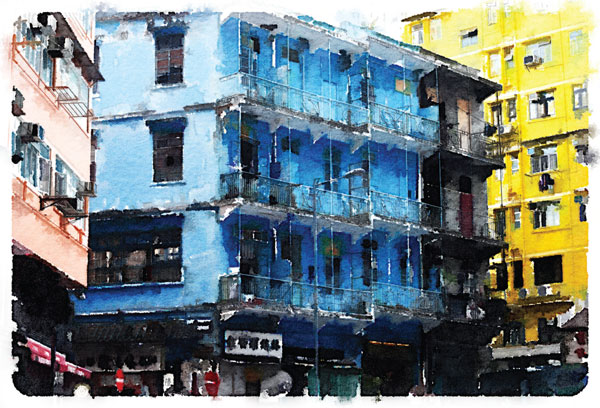The magnificent 7
Updated: 2015-01-13 06:01
By Chitralekha Basu(HK Edition)
|
|||||||||
|
The Blue House in Wan Chai, a 1920s tong lau building, got its name and the indigo coat only in 1996, and by default, as there was excess paint to be disposed of. Provided to China Daily |
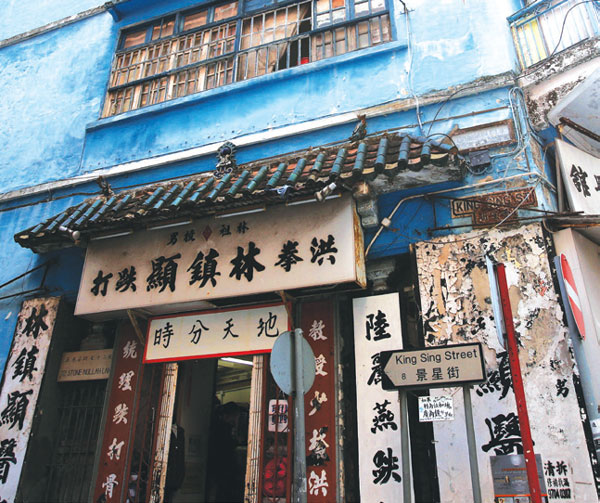
Chitralekha Basu visits some of Hong Kong's most piquant heritage structures, named after the color they wear, or once did.
A post on the portal gwulo.com, dedicated to Hong Kong nostalgia, is where this story begins.
The discussion thread we're talking of had to do with a property at 33 Magazine Gap Road, on the way to the Peak. David Bells, who runs gwulo, posted photos of the classical European Renaissance-style three-storey building - renovated between 1945 and 1952, likely built even earlier. Bells was trying to pin down the year. He invited fellow members of the forum to chip in.
People who lived in that house, or knew someone who did, wrote in.
"Ah, the Pink House!" gushed hklovejoy. "My family and I lived there from 1986 to 1994, middle floor, west side, and, of all the properties (11 of them) we lived in during my husband's 27 years with HSBC, this was our favorite." However, the writer differed with the Antiquities and Monuments Organization's suggestion (quoted by Bells in his post) that the upper floors had "'sadly' been painted pink". It's "more of a terracotta color," hklovejoy contended, "but with the mortar lines picked out in white it looked pink from a distance. And much nicer than plain old brick, if you ask me."
Evidently, it was a house full of memories, and elicited strong, heartfelt reactions in people who had some association with it. And it's not difficult to see why. Tucked away in a terrace above Magazine Gap Road, the property is accessible only through a private driveway. The faade, with Corinthian columns and entablature cascading down in enormous half circles, is indeed spectacular. But what's even more so is the mature pink on its walls - a shade so subtle, it's almost not there.
Looking at the range of emotions the Pink House - as high-ranking HSBC officials who have lived there since the 1960s would fondly call it - had stirred, we wondered if other buildings in Hong Kong, named after the coat they wore, meant anything in particular to the people who passed through their doors.
Research showed most of the houses on our list had sported a different color altogether at the outset. They were painted over at a later stage. These moments of transition from one color to another could be read as signposts in Hong Kong's architectural history, as well as a register of a society that's steadily evolving. As Edward Leung, director, Aedas - one of Hong Kong's prominent architectural enterprises - and also faculty at the architecture department at University of Hong Kong- says, "The need or desire to apply color, whatever the chrome, is of architectural significance. The act of applying color itself is a matter of social significance; whereas the chrome - red or blue - is less meaningful."
Quite a few of Hong Kong's heritage buildings are defined by their color, in the past or present. The office of Yau Ma Tei Theatre is better known as the Red Brick House. The Comix Home Base center at Mallory Street in Wan Chai, though now painted pristine white, is still referred to as the Green House. The colors these buildings are/were give them their most instantly recognizable identity. It's as if the pigment they wear/wore is the most important thing about them.
Conversely, a bright hue is a magnet in itself. Applied to a house, it draws people to access all that is concealed underneath the paint - history, architectural style, heritage value, if any, functionality, and yes a whole archive full of experiences.
The blue cluster
The Blue, Yellow and Orange house cluster at 72-74A Stone Nullah Lane, is a good illustration of color marking a signpost in history. The Blue House - a 1920s tong lau (tenement building with residential and shop units, and a common balcony, typical of East and Southeast Asia) - was dyed the shade of indigo only in 1996. "There was excess paint the government wanted to dispose of," says Tim Lo, who runs Hong Kong House of Stories (HOS), a walk-in cultural space stacked with second-hand books, long-play vinyl discs and retro furniture, from the premises. "Private owners didn't want their portions of the building painted, so those were left un-touched," he says, pointing to the dark phalanx of flats on one side. "Blue is a very inauspicious color by traditional Chinese reckoning."
But such a taboo will probably not come in the way when the Viva Blue House Project - including the Yellow and Orange buildings adjacent to it - is completed in 2015. "Usually, conservation entails rehabilitating the people in the existing building. But in this case Saint James' Settlement (in charge of local community development) worked in tandem with artists, architects and tenants to put together an alternative plan so that tenants could continue living here."
Even as we talk about how the residents of the building meet up every Thursday to work out the best ways of fostering the spirit of this heritage-rich pocket of Wan Chai by hosting cultural tours and engaging more children in community-oriented activities, a lady walks in, lugging a small suitcase. She is thinking aloud as she keeps gazing at the exposed lintel beams holding up the unusually high ceiling. "There used to be a mezzanine floor over here," she says, with a tinge of longing. "Oh, those were the days."
It turns out she, Rita Yuen, used to work in this very space 30 years ago, as secretary to an interior designer firm owner. As she recalls what a lovely pair her then boss and his wife, who would bring home-cooked lunch for the whole workforce every day at noon, Yuen says she is "grateful to see this antique building still remain when so many others got pulled down". "I should thank the people of this neighborhood," she says. "They fought for its conservation, retaining its original character."
Red and white
The cute factor of the Red Brick House at 344 Shanghai Street is enhanced because of the backdrop. Originally a pumping station, built in 1895, it is almost like a puppy playing at the feet of its giant neighbor, a humongous apartment block. This is the only house on our list named after its original color, i.e. that of the bricks. Jannie Fan, who holds the fort for Yau Ma Tei Theatre here, as its manager of programs, informs that the luminous tangerine red color of the brick, that we now see, is, in fact, a result of a thorough scrub "a century's worth of oil and dirt were removed from the walls of the Red Brick House through chemical treatment. What you see now is just like what you get after peeling off a facial mask".
She points to a patch on the wall, with a bit of writing on it, that has been left un-touched, to show the original tint. "This place was being used by vagabonds to sleep at night," she says. The major facelift happened when the government decided to turn the structure into a venue for Cantonese opera workshops cum booking office in 2012.
A hop across the road from here is the White House - an art deco structure, which used to be a cinema hall and kung fu display place in the 1930s. Unable to cope with dwindling audiences, the theater was screening only soft-porn imported from Japan, until the inevitable closure happened on July 31, 1998.
Yuko Cheung, project manager at the Chinese Artist's Association of Hong Kong, has been witness to a series of serendipitous discoveries since the renovation work began in 2009. These include white pillars with abstract images of happy and sad-faced Chinese masks when a brick wall was pulled down. The proscenium arch was concealed for years behind the film screen. The findings also suggested what the color of the original structure was: a buttery shade of brilliant white.
"My favorite question to ask when I'm showing someone around is: between the grey, black and wooden trusses holding up the roof, which one do you think is the oldest?" says Cheung, pleased to hand out a nugget of living history.
"Surprisingly, the grey metal framework is as old as the wooden logs. They are part of the original fortification of this place."
How green was my home
Connie Lam would often pass by the Green House at 1-11 Mallory Street - a densely-stacked array of buildings with narrow reinforced concrete balcony. The Western influence was apparent in the large French windows, cast iron pillars and iron balustrades. By the time she came to work here in 2013 as the executive director of Comix Home Base, the building was a swanky new white structure. "I liked the building then but I think it's far more beautiful now," she says. "It feels great that when we put up an exhibition, people come here to see both the show and the architecture."
The loss of the original color hardly makes a difference, she says.
Leung, who was, literally, the architect of this HK$200 million-renovation project, flipped for white as that was probably the color the building originally wore.
"Our research team found a typical tong lau from the early 1910s should have had off-white lime plaster on a brick wall. So we decided to revert to that," says Leung. The green pigment, he contends, was applied much later. Nevertheless, doffing his cap to the fact that the earlier green color is now a part of people's collective memory and is "still respected as a socially memorable concept", he decided to have "an abundance of green walls" inside and "plants on the balconies in the revitalized building". The objective was to give the "greenest" of buildings a contemporary twist, he says.
Contact the writer at basu@chinadailyhk.com
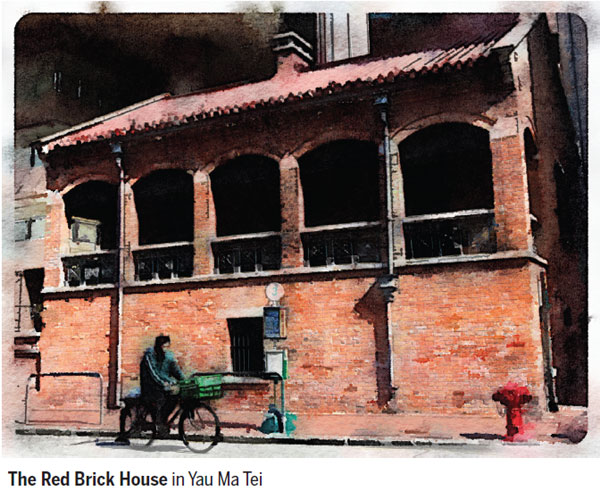
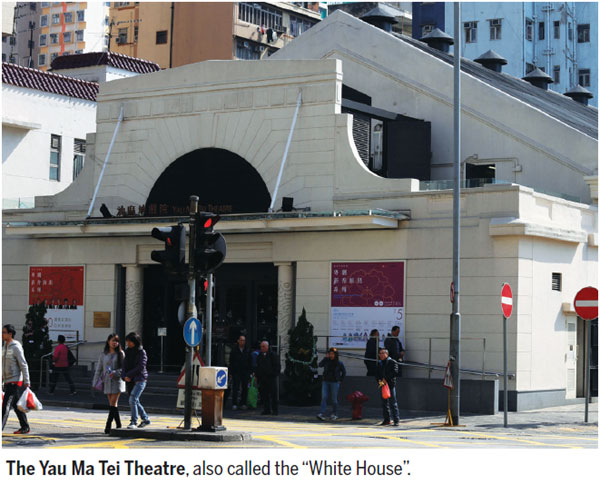
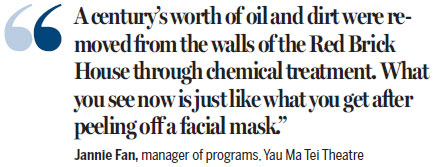
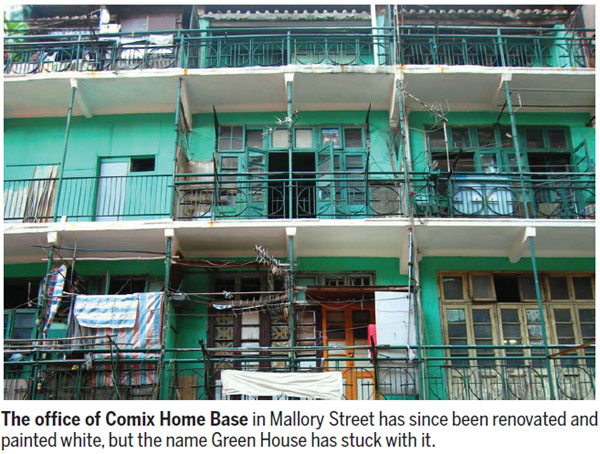
(HK Edition 01/13/2015 page7)
